Latest posts by (see all)
- The Best Things to Do in Tulsa - June 26, 2020
- The Most Interesting Things to Do in Springfield Mo - June 15, 2020
- Best Things to Do in Salt Lake City - May 26, 2020
- 10 Best Websites for Playing Online Games - May 22, 2020
 Colorful Dublin knows how to captivate the traveler – with thousands of years of historical monuments, interesting museums and simply indescribable spirit of a proud, independent and cheerful Ireland. The abundant sights of the Irish capital may well be envied by the “promoted” cities of the UK’s neighbors: St. Patrick’s Cathedral and Christ’s Cathedral, Dublin Castle, the famous Trinity College with the masterpiece of medieval typography – the Book of Kells, the exciting National Maritime Museum and the incredible Leprechauns Museum, the Guinness Brewery, and the Jameson Distillery Museum. Are you intrigued and want to learn more about the things to do in Dublin Ireland? Then, don’t waste time and check what you can do in Dublin when having a vacation.
Colorful Dublin knows how to captivate the traveler – with thousands of years of historical monuments, interesting museums and simply indescribable spirit of a proud, independent and cheerful Ireland. The abundant sights of the Irish capital may well be envied by the “promoted” cities of the UK’s neighbors: St. Patrick’s Cathedral and Christ’s Cathedral, Dublin Castle, the famous Trinity College with the masterpiece of medieval typography – the Book of Kells, the exciting National Maritime Museum and the incredible Leprechauns Museum, the Guinness Brewery, and the Jameson Distillery Museum. Are you intrigued and want to learn more about the things to do in Dublin Ireland? Then, don’t waste time and check what you can do in Dublin when having a vacation.
Contents
- Thing to do number 1: Visit the Old Jameson Distillery
- Thing to do number 2: Go to the Cathedral of Christ
- Thing to do number 3: Have a walk in the Dublin Botanical Garden
- Thing to do number 4: Visit the National Museum of Leprechauns
- Thing to do number 5: Have a walk in the Garden of Memories
- Thing to do number 6: Go to the Phoenix Park
- Thing to do number 7: Have a look at the monument to Molly Malone
- Thing to do number 8: Go to the Guinness Brewery Museum
- Thing to do number 9: Visit the Library of the Trinity College to see the Book of Kells
- Thing to do number 10: Visit the National Maritime Museum
- Thing to do number 11: Enjoy night life in the Temple Bar
- Video
Thing to do number 1: Visit the Old Jameson Distillery
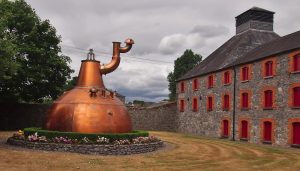 A visit to Dublin cannot be imagined without a visit to the holy of holies of the capital of the country and the whole of Ireland – the Old Jameson Distillery whiskey museum. Since 1780, it is here that the national drink of the Irish is produced – a magnificent whiskey of one of the most famous brands in the world. Viskies of the distillery are waiting for an informative and fun journey into the world of whiskey – as you may have guessed, it is becoming more and more fun every minute, because tasting is an obligatory element of the program. Jameson Distillery Museum is located in the historic district of Dublin Smithfield, so that the way here will be full of impressions of a considerable number of attractions around.
A visit to Dublin cannot be imagined without a visit to the holy of holies of the capital of the country and the whole of Ireland – the Old Jameson Distillery whiskey museum. Since 1780, it is here that the national drink of the Irish is produced – a magnificent whiskey of one of the most famous brands in the world. Viskies of the distillery are waiting for an informative and fun journey into the world of whiskey – as you may have guessed, it is becoming more and more fun every minute, because tasting is an obligatory element of the program. Jameson Distillery Museum is located in the historic district of Dublin Smithfield, so that the way here will be full of impressions of a considerable number of attractions around.
- Acquaintance with the museum begins with the facade – it completely preserved the original appearance of the 18th century.
- Further, visitors are held in the lobby, where everything is permeated with the atmosphere of production and distribution of the national pride of Ireland.
- During the one-hour excursion (visiting the whiskey distillery is possible only as part of an organized group) you will see all the details of the whiskey distillation process – from sorting the malt at the first stage to distillation cubes, heaters, distillers and, finally, whiskey aging containers branded bottles.
After the production process is “mastered”, it’s time to start tasting. Visitors are invited to get acquainted with the Jameson whiskey of different “labels” and try to determine the taste, which one is the most seasoned. Regardless of how “talented” your taste buds are, in the end you will have the honorary certificate of the whiskey taster.
Interesting: If you want to immerse yourself in the atmosphere of the distillery to the fullest, welcome to the Jameson Cooper Festival. On Thursdays and Saturdays from May to October, a whiskey-party with live folk music, good Irish cuisine and, of course, good portions of Jameson whiskey awaits you.
Thing to do number 2: Go to the Cathedral of Christ
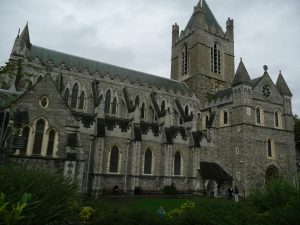 The main cathedral of Dublin and one of the three oldest cathedrals of the city, the Cathedral of Christ boasts an exceptional age: it was founded already in 1031 by the Viking King Sitrig. The Cathedral of Christ is honored by both Dublin archbishops at once – Catholic and Anglican, which testifies to the exceptional nature of the church. But tourists are attracted here by the history no longer covered with dust of centuries, but by the merry modernity of Dublin: among the exhibits of the museum of the cathedral are rats and cats mummies, preserved in the musical organ a couple of centuries ago.
The main cathedral of Dublin and one of the three oldest cathedrals of the city, the Cathedral of Christ boasts an exceptional age: it was founded already in 1031 by the Viking King Sitrig. The Cathedral of Christ is honored by both Dublin archbishops at once – Catholic and Anglican, which testifies to the exceptional nature of the church. But tourists are attracted here by the history no longer covered with dust of centuries, but by the merry modernity of Dublin: among the exhibits of the museum of the cathedral are rats and cats mummies, preserved in the musical organ a couple of centuries ago.
Starting an acquaintance with the cathedral is from the main entrance. Its facade was re-faced in 1875, but Norman and Early English architectural elements can be traced clearly. The magnificent Romanesque portico “moved” here from the northern facade at the end of the 19th century, and not far from it you can see the ruins of the 13th century – the priest’s house was located here.
- Inside, it is worth seeing the tomb of the 12th century Strongbow Knight with the painstaking depiction of full knightly weapons.
- In the statue, most likely, there are cavities designed to bury the internal organs of the venerable husband. Cross aisles and choirs are the oldest parts of the cathedral, dating from the 12th to 13th centuries.
- In the south aisle, you can see the chapel of St. Lawrence with a valuable relic – the embalmed heart of the saint. Ceramic tiles on the floor of the original chapel, 13th century.
Then you should definitely go to the underground part of the cathedral – the crypt. This is the oldest building of all Dublin, dating back to the beginning of the 12th century. The permanent exhibition “Treasures of the Cathedral of Christ” presents artifacts associated with worship in the temple: manuscripts, candlesticks, and other church utensils.
Interesting: The most amazing exhibit is also exhibited here: the rat and the cat mummified in a natural way, which once chased it, were removed from the organ of the cathedral during its cleaning in 1860.
Thing to do number 3: Have a walk in the Dublin Botanical Garden
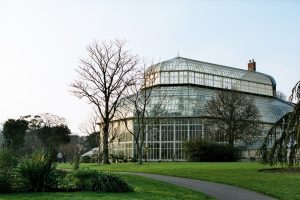 The magnificent Dublin Botanical Garden occupies an impressive area of 25 hectares in the heart of the Irish capital. “The green heart of Dublin”, as locals lovingly call it, boasts twenty thousand all kinds of plants from all over the world. But the numerous visitors to the Dublin botsad are primarily interested in something else:
The magnificent Dublin Botanical Garden occupies an impressive area of 25 hectares in the heart of the Irish capital. “The green heart of Dublin”, as locals lovingly call it, boasts twenty thousand all kinds of plants from all over the world. But the numerous visitors to the Dublin botsad are primarily interested in something else:
- shady lawns,
- luxurious greenhouses,
- and a mass of blooming and fragrant flower beds, among which it is so pleasant to rest, contemplating nature.
The Dublin Botanic Garden was founded in 1795. Over the past two hundred years, there have appeared thematic gardens connected by picturesque ponds and canals, multi-tiered alpine slides and bright multi-colored flowerbeds. The Palm House deserves special attention, where the representatives of this plant family from all over the world delight the eye of visitors. The residents of Dublin like to arrange morning jogging on the paths of the garden.
Interesting: The entrance to the Dublin Botanical Garden is free, it is open daily until 5:00 pm on weekdays and until 6:00 pm at the weekend.
Thing to do number 4: Visit the National Museum of Leprechauns
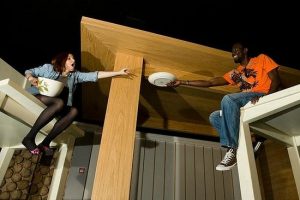 The National Museum of Leprechauns in Dublin opened just four years ago, but instantly won the love of locals and tourists. Here ancient Irish legends about dwarfs in green clothes come to life, protecting their pots of gold. According to the creators of the museum, the visitor should not just learn about leprechauns, but become one of them, which is facilitated by the giant furniture, a real corner of the forest with a well, and an amazing rainbow that opens the way to the treasured golden pot.
The National Museum of Leprechauns in Dublin opened just four years ago, but instantly won the love of locals and tourists. Here ancient Irish legends about dwarfs in green clothes come to life, protecting their pots of gold. According to the creators of the museum, the visitor should not just learn about leprechauns, but become one of them, which is facilitated by the giant furniture, a real corner of the forest with a well, and an amazing rainbow that opens the way to the treasured golden pot.
Everything here was created so that visitors could try on the role of a leprechaun.
- To begin with, they are introduced to Irish folklore: they tell us who such leprechauns are and what they are famous for.
- The tour continues in the “historical” halls of the museum: here you can find out how the topic of leprechauns became popular in popular culture, for example, in popular cartoons. Well, and then begins “leprechaun-experience”: you find yourself in a room with giant interior items, try to jump on a chair and sit at the table.
- The excursion ends in the Leprechaun forest, where you can go down into the well and make a trip, following the rainbow, to the golden treasure.
Interesting: The authoritative The Irish Times enthusiastically responded to the opening of the National Museum, calling it the Louvre of Leprechauns.
Back
Thing to do number 5: Have a walk in the Garden of Memories
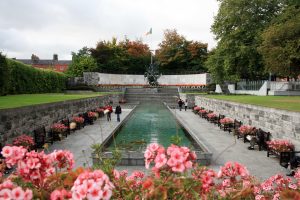 The favorite place of walking of the Dubliners, the luxurious Garden of Memories owes its name to the memorial, established here in memory of those who gave their lives for the freedom of the Irish people. Despite the sad cause of its occurrence, the garden is full of life-affirming magnificence of nature:
The favorite place of walking of the Dubliners, the luxurious Garden of Memories owes its name to the memorial, established here in memory of those who gave their lives for the freedom of the Irish people. Despite the sad cause of its occurrence, the garden is full of life-affirming magnificence of nature:
- there are a lot of wide alleys with comfortable benches,
- lush trees,
- and a remarkable number of plants, including exotic ones.
The Garden of Memories dates back to 1966. A vast stretch of green territory existed here before, but in honor of the fiftieth anniversary of the historic Easter Rising, the city authorities decided to lay “ideological soil” under it. So, here was a memorial in memory of several uprisings for the freedom of Ireland, the last of which was the war of independence of 1919-1921.
Interesting: In addition to walks on well-groomed paths, on the lawns of the Garden of Memories it is not forbidden to enjoy a picnic, which is confirmed by numerous families in Dublin, who gladly arrange “breakfast on the grass”.
Thing to do number 6: Go to the Phoenix Park
 The legacy of medieval Dublin, founded in the 17th century Phoenix Park – two pleasures in one. Here you can:
The legacy of medieval Dublin, founded in the 17th century Phoenix Park – two pleasures in one. Here you can:
- walk along well-groomed paths,
- relax on cozy benches in the shade of ancient trees,
- or go to get acquainted with the fauna from all over the world at the Dublin Zoo, which is located here.
Dublin Phoenix Park is spread over a huge area of more than 500 hectares, which brought him fame as the largest fenced park in Europe. Unlike the Botanical Garden, one cannot find exotic species of plants and masterpieces of landscape design here but this is a real wildlife preserve in the center of the European capital. Even more surprising is the fact that Phoenix Park is home to a population of red deer, who are absolutely not afraid of visitors and willing to pose for a photo for a small tasty reward.
Interesting: Phoenix Park is also a historic place. Here are the presidential residence, the Wellington Memorial and the monument-cross, opened by John Paul II. The park is open to the public daily, admission is free.
Thing to do number 7: Have a look at the monument to Molly Malone
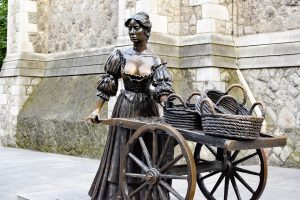 The monument to Molly Malone, located on Grafton Street, one of the most interesting and legendary monuments of the Irish capital. It depicts the heroine of the national song of the same name. Rare Irishman does not sing it, leaving the pub on Friday night, so the story of Molly Malone can be memorized without delving into the songbooks.
The monument to Molly Malone, located on Grafton Street, one of the most interesting and legendary monuments of the Irish capital. It depicts the heroine of the national song of the same name. Rare Irishman does not sing it, leaving the pub on Friday night, so the story of Molly Malone can be memorized without delving into the songbooks.
- The song about Molly Malone – the story of a girl selling oysters and mussels in the honest city of Dublin.
- The plot is simple: the Irish, according to family tradition, went into commerce, which killed her: the poor thing fell feverish, after which the ghost with a seafood cart began to drive around the streets of the capital.
Interesting: The monument to Molly is made of bronze and installed in 1987 in honor of the Millennium of Dublin on Grafton Street, not far from the Church of St. Andrew (the place of baptism of the heroine) and Trinity College (part-time job).
Thing to do number 8: Go to the Guinness Brewery Museum
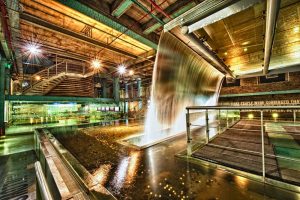 Legendary beer begins its history back in 1752. Then the unknown Arthur Guinness inherited 200 pounds. To celebrate the money he, of course, spent on drinking. But he did it as reasonably as possible – he rented a brewery.
Legendary beer begins its history back in 1752. Then the unknown Arthur Guinness inherited 200 pounds. To celebrate the money he, of course, spent on drinking. But he did it as reasonably as possible – he rented a brewery.
After 40 years, Arthur died a wealthy man, leaving his life to his sons. For 200 years, the descendants of Arthur Guinness have turned the family business into a global brand. Today, anyone who happens to be in Dublin is simply obliged to visit the Guinness brewery museum.
On the 7 floors of the museum, you can:
- see a lot of interesting facts from the foundation of the brewing company,
- as well as become a direct participant in the creation of this delicious drink: the museum has a button to launch a new batch of beer, which anyone can click at a certain time.
Visitors can try beer at different stages of its preparation, as well as independently pour themselves various varieties of Guinness for tasting. On the top floor is the pub “Gravity”, where you can exchange a ticket for a pint of freshly brewed beer and enjoy the panorama of the city. Perhaps, this is one of the best panoramic sites in the whole of Dublin (and not only because of the freshly brewed dark drink of the Gods).
Interesting: It is located in the former production area and inside it has the form of a company branded glass.
Thing to do number 9: Visit the Library of the Trinity College to see the Book of Kells
 The Book of Kells is a collection of riddles that have come down to us through a thousand years. Until now, no one can understand what the colors were used by the monks, because they have not faded and have kept their brightness to this day. It is also not clear how it was possible to create such elegant miniatures without using a magnifying glass.
The Book of Kells is a collection of riddles that have come down to us through a thousand years. Until now, no one can understand what the colors were used by the monks, because they have not faded and have kept their brightness to this day. It is also not clear how it was possible to create such elegant miniatures without using a magnifying glass.
- The manuscript experienced a lot in his lifetime: it was abducted, as a result of which a number of ornaments and several sheets were lost, it changed the place of storage several times. The book was repeatedly restored, and not always it was good for it.
- So, in the 18th century, the Book of Kells was decided to be re-woven; for this, some of the pages were cut to fit them into a single format.
- As a result, some of the images have irretrievably gone.
Nevertheless, throughout the entire period of time, the book was carefully kept until it finally found a house in Trinity College, Dublin, where it is still kept. Visit the library of Trinity College, which, by the way, is considered one of the most beautiful libraries in the world, can be very simple, paying for the entrance.
Interesting: The Book of Kells was created around 800 and presents a collection of four Gospels with a preface.
Thing to do number 10: Visit the National Maritime Museum
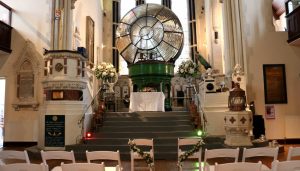 Thing to do number 10: Located in the once suburb of Dublin, and now its full-fledged district of Dan-Lara, the National Maritime Museum of Ireland is a detailed testimony to the rich history of the country’s navigation and maritime commerce. In addition to interesting exhibits – models of historic sailing vessels and ship life items – here you should pay attention to the building itself: the museum occupies the premises of the old church of St. Michael.
Thing to do number 10: Located in the once suburb of Dublin, and now its full-fledged district of Dan-Lara, the National Maritime Museum of Ireland is a detailed testimony to the rich history of the country’s navigation and maritime commerce. In addition to interesting exhibits – models of historic sailing vessels and ship life items – here you should pay attention to the building itself: the museum occupies the premises of the old church of St. Michael.
The basis of the museum’s exposition is artifacts associated with the work of the historic ship “Great Eastern”, which laid the cable along the bottom of the North Sea. The captain of the vessel painstakingly collected an extensive collection of materials:
- logbooks,
- archival photos,
- drawings and various testimonies.
Also, in the museum, you can see the model of the legendary ship “Sirius” – the first ship on the steam engine, made the transition across the Atlantic.
Interesting: The largest exhibit of the maritime museum – and still working lantern, shot from the lighthouse of Bailey in North Dublin. It was designed in 1902 and shone with a power unprecedented in those times – 2 million candles!
Thing to do number 11: Enjoy night life in the Temple Bar
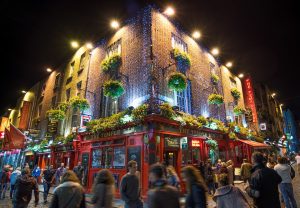 Temple Bar – the most “night” district of Dublin. There is constantly moving through the streets of a small, but moderately dense crowd. And all because this place is chosen by local youth for the presence of pubs, bars, restaurants and night clubs. It is not surprising that tourists cannot get around Temple Bar either! Almost every door in the Temple Bar area leads to a pleasure institution where Guinness flows like water.
Temple Bar – the most “night” district of Dublin. There is constantly moving through the streets of a small, but moderately dense crowd. And all because this place is chosen by local youth for the presence of pubs, bars, restaurants and night clubs. It is not surprising that tourists cannot get around Temple Bar either! Almost every door in the Temple Bar area leads to a pleasure institution where Guinness flows like water.
But you should not think that the second part of the name Temple Bar means exactly the eatery. In fact, the area got its name because the property of Sir Temple stood on the banks of the river. And the word “bar” means “steep, steep shore”. Therefore, the name is quite decent.
The most popular bars here are:
- The Temple Bar,
- The Quais,
- The Auld Dub.
Interesting: Closer to the weekend and often in the evenings, you can listen to the musicians playing here and sing on your own if you wish.